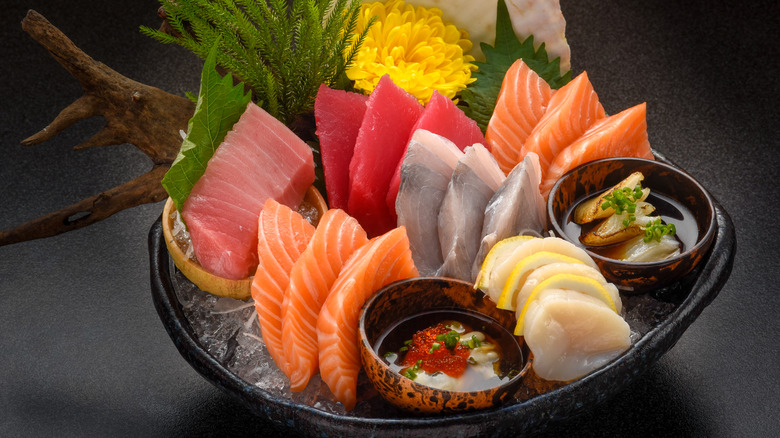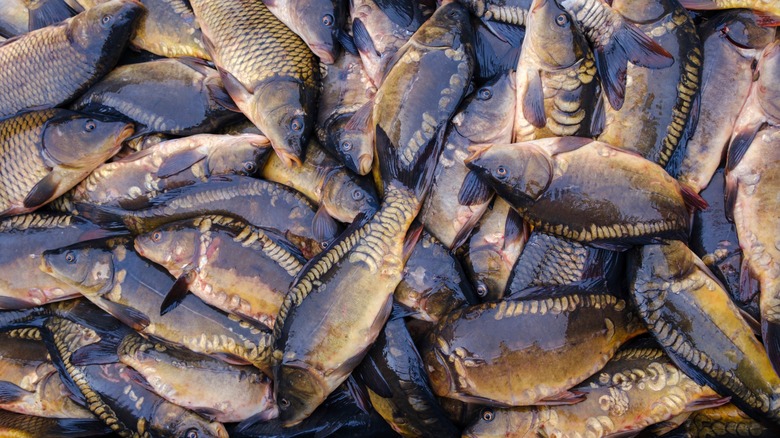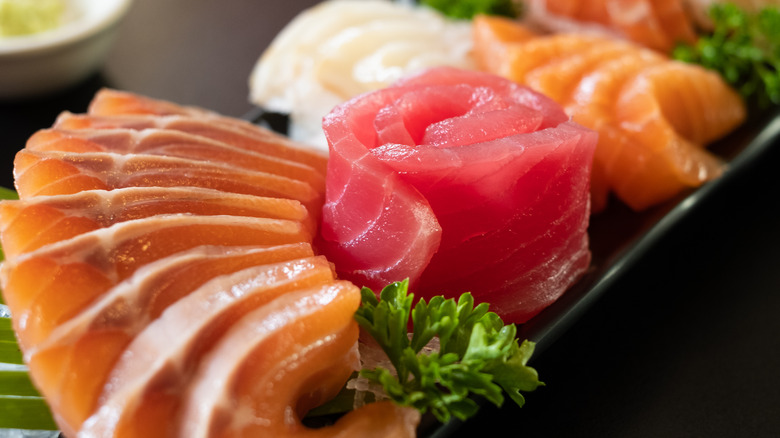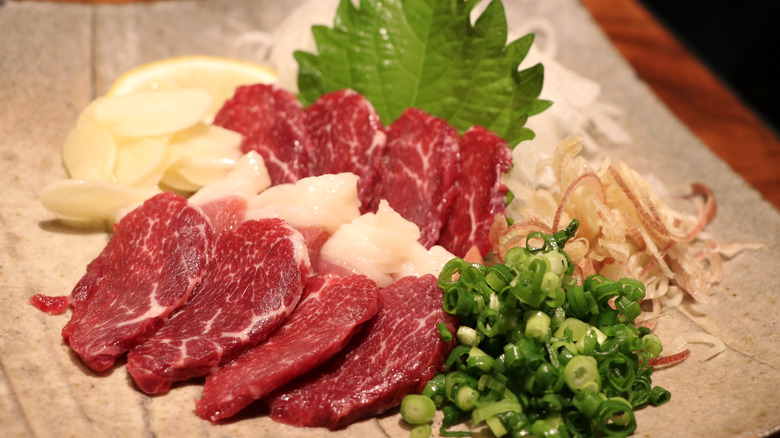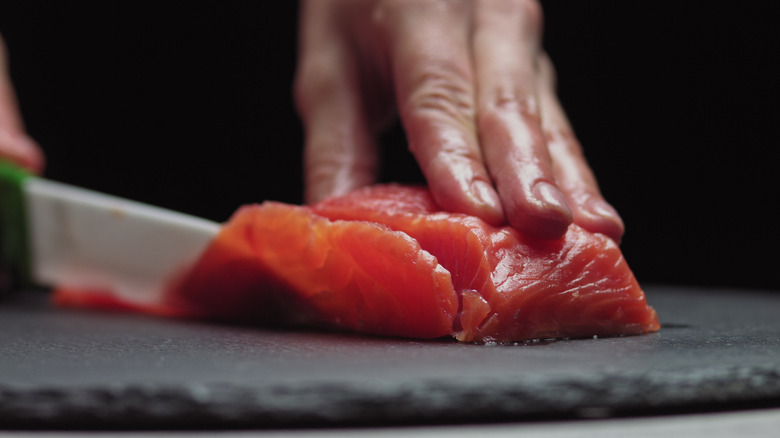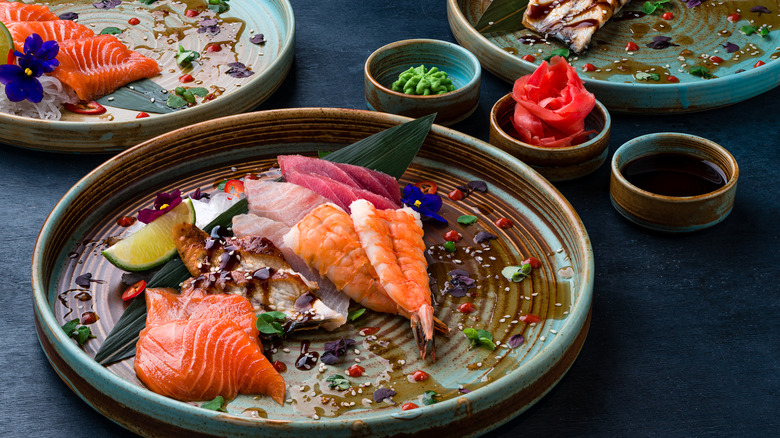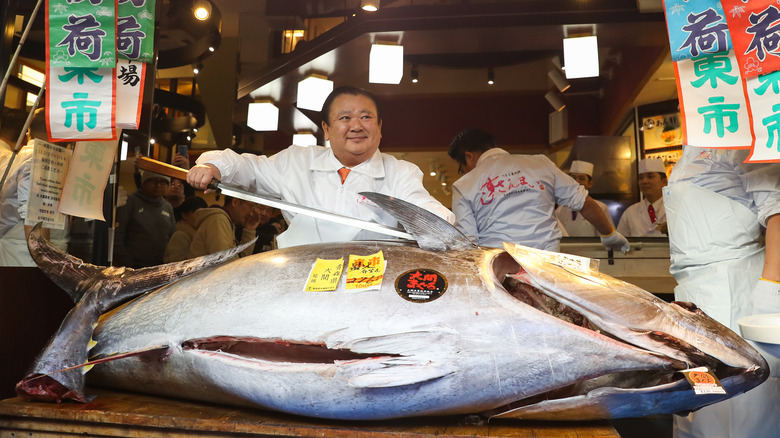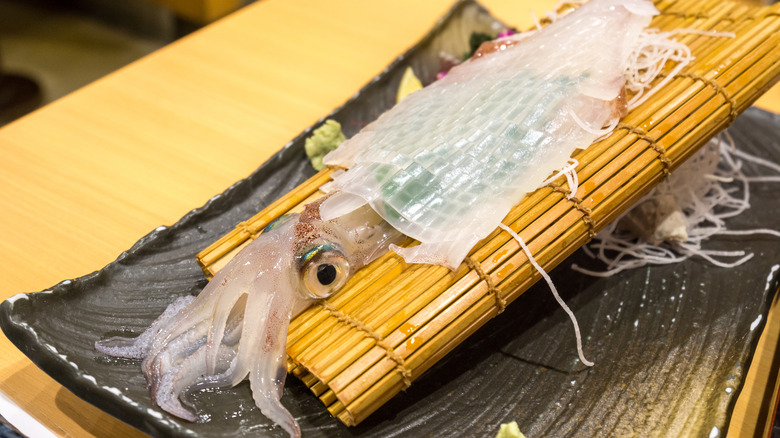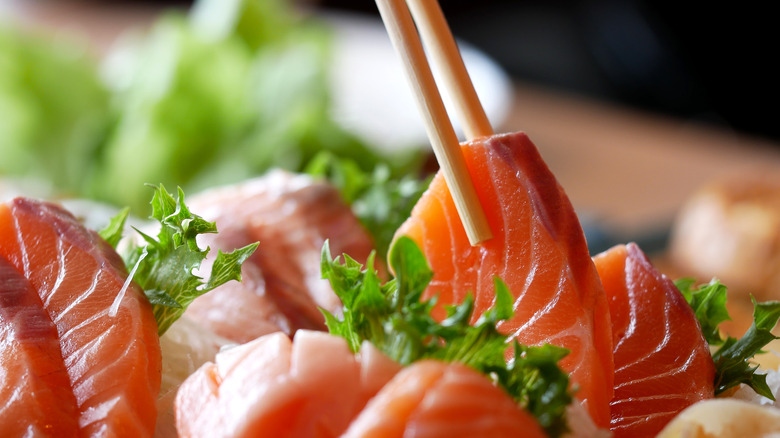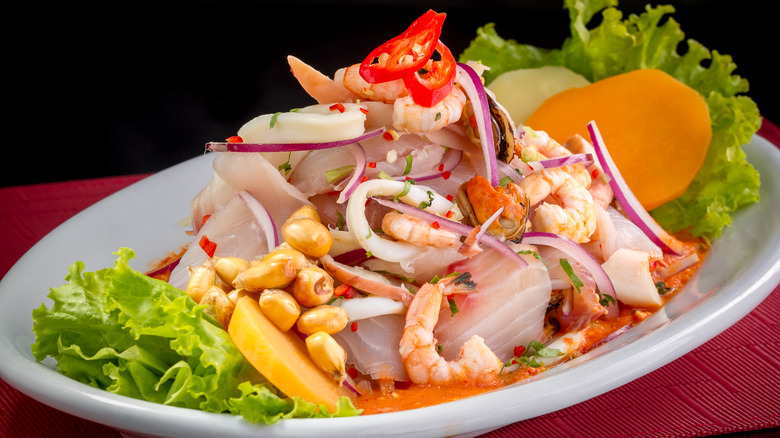The Untold Truth Of Sashimi
Translating to "pierced body" in Japanese, sashimi is the culinary tradition of eating raw seafood and meat. Some of the most popular sashimi ingredients include tuna, salmon, yellowtail, squid, shrimp, as well as raw beef. Not to be confused with sushi, which is a dish made from raw seafood and vinegared rice, sashimi is served in slices alongside condiments and garnishes. And while the two dishes are distinct, sashimi can be found at most sushi restaurants. In Japan sashimi is usually served as an appetizer, however, it can also be eaten with rice and miso soup as a part of the main course (via RB Sushi).
While sashimi has been popular in Japan for centuries, the culinary art didn't make its way to Western countries until the mid-1960s. American food journalist and restaurant critic Craig Claiborne wrote at the time, "New Yorkers seem to take to the raw fish dishes, sashimi and sushi, with almost the same enthusiasm they display for tempura and sukiyaki," which he referred to as less "far out" Japanese dishes. Today, the tasty tidbits have gained worldwide popularity, with over 4,000 sushi and sashimi restaurants in the U.S. alone (via Mental Floss).
The origins of sashimi are uncertain
There are many different theories about the origins of sashimi. What we know for sure, however, is that historically the culinary tradition could only be enjoyed along coastal regions due to the lack of refrigeration. Luckily, Japan consists of hundreds of islands, meaning that fresh seafood was available in many locations. According to one theory, sashimi, as we know it today, draws its roots from a dish of thinly sliced raw fish marinated in seasoned vinegar called namasu, which was a favorite in Japan during the Heian period between the 8th and 12th centuries (via Live Japan).
Regardless of its origin, scholars do agree that sashimi became popular in Japan during the Edo period between 1600 and 1867. Sushi came soon later with the invention of nigiri, or a combination of vinegar-seasoned rice with slices of raw fish, which appeared before the start of the 19th century. Different sushi styles were soon developed and sushi restaurants mushroomed in Japan (via Ja Bistro). Meanwhile, America got its first taste of sashimi in the 1960s with the opening of the country's first sushi restaurant in Little Tokyo in Los Angeles (via RB Sushi).
The range of seafood that can be classified as sashimi is huge
Since different seafood features different flavors and textures, not all sashimi is created equal. Probably the most common sashimi dishes are made from tuna and salmon. Japan Guide explains that tuna comes in akami, or the red lean and firm part of the fish, and the more highly-regarded toro, or the pink and more fatty part of the fish. Meanwhile, salmon is usually orange, fatty, and tender. Other popular sashimi is made from sea bream, mackerel, yellowtail, and amberjack.
Aside from fish, shellfish and mollusks are also popular sashimi options. Squid sashimi is made from the mantle rather than tentacles, with the firm and mild-flavored flesh often cut into thin strips. Octopus legs are also often used in sashimi. While these can be served raw, they are sometimes also poached to bring out a slightly sweeter flavor. Shrimp sashimi is usually served without a shell, save for the tail, which is edible. Two other shellfish sashimi choices include scallops and surf clams. Sashimi can also come in the form of salmon roe and sea urchin.
Sashimi can be made from meat
While seafood is synonymous with sashimi, the delicacy is also sometimes made from meat such as beef and chicken. The most commonly used sashimi beef is marbled Wagyu beef. Cut into slices, the beef is praised for its thin ribbons of fat. While not as common, chicken sashimi does exist. According to Newsweek, the most popular restaurant that serves chicken sashimi on the West Coast is Ippuku in Berkeley, California. "Our chickens come in with the heads and feet on, and the rigor mortis is still so fresh in them that you can stand the chickens up by their legs," the restaurant's founder and chef Christian Geiderman said.
Meat sashimi is sometimes also made from more unusual ingredients such as horse meat, deer, and even sea turtle. The tradition of horse sashimi, which started in Japan during the country's food shortage in the late 16th century, was revived in the 1960s when horses were being replaced by cars and agricultural machinery. Similar in appearance to tuna, raw deer meat is a firm favorite in certain areas of Japan such as Wakayama. Sea turtle sashimi can only be found on Japan's Bonin Islands where it is served seasonally (via Modern Farmer).
Sashimi-grade seafood is just a marketing term
While the label sashimi-grade may put you at ease when buying raw fish, the term is more or less meaningless as the product isn't regulated in the U.S. Nevertheless, many vendors use the marketing term to indicate which of their stock is the freshest and of the highest quality. To make a long story short, the label is only as dependable as the vendor behind it.
While the US Department of Agriculture (USDA) grades the country's beef, there is no similar body that grades fish. This said, the Food and Drug Administration (FDA) regulates the handling of fish destined for raw consumption. In particular, the organization recommends the temperatures and storage times that kill parasites in different types of fish. Since some of these temperatures can be as low as -31 degrees Fahrenheit, it's probably best to leave the handling of raw fish to the experts at your local Japanese restaurant (via Serious Eats).
Cutting sashimi is a fine art
While it may appear simple, cutting sashimi is considered a culinary art. As RB Sushi explains, the most common sashimi slicing style is called hira zukuri, where the seafood is cut into ⅜-inch slices. Meanwhile, the usu zukuri method of sashimi preparation involves cutting the seafood into slices so thin that they appear almost transparent. The head chef at Sake Restaurant and Bar, Yonge Hyunchul Kim described the sashimi preparation process to Broadsheet, highlighting that the thickness of the slices should depend on the fish type. "First we take the head and tail off. Then cut around from the head to the tail following the backbone. Then you need to take the rib bones out. If it's salmon, which is quite soft, cut it thickly. Probably up to 6 – 7 millimeters. If it's snapper or any other white fish it will have quite a lot of sinew, so it's better to cut less than 2 millimeters."
One unique trait of sushi and sashimi knives is their single beveled edge. This means that only one side of the knife features a cutting edge while the other side remains flat. The flat edge is there to ensure that the food doesn't stick to the knife. While razor-sharp sashimi knives are called yanagiba, when it comes to cutting through cartilage or fish bones, most chefs use a meat cleaver-style knife called deba (via Secrets of Sushi).
Sashimi can be paired with a range of accompaniments
Sashimi is usually accompanied by a variety of seasonings to cut the fishy flavor and smell of the oilier fish. Most sashimi comes with a soy dipping sauce and a spicy paste called wasabi. Sushi restaurants typically feature small carafes of soy sauce on each table and a tiny soy dish near each place setting. Diners pour a small amount of the soy sauce from the carafe into the dish and dip their sashimi pieces in the receptacle. Made from ground Japanese horseradish, wasabi shouldn't be mixed with soy sauce before consumption but rather placed directly on the sashimi. It's important not to overindulge in either one of the condiments, as they can easily overpower the flavor of the seafood (via Osaka Japanese Bistro).
Sashimi is commonly served on a bed of shredded daikon, or white radish, and green shiso leaves — this garnish is referred to as tsuma. Cut into beautiful shapes, such as flowers, these accompaniments are meant to not only camouflage the smell of the fish but also stimulate the appetite. Sashimi also often comes with pickled ginger, which is meant to cleanse the palate between different fish flavors. Ginger should never be eaten directly with sashimi pieces (via Shiso Soy).
The most expensive sashimi ever sold cost $5,000 per pound
A Japanese sushi chain owner Kiyoshi Kimura forked out $3.1 million for a 612-pound bluefin tuna — that's around $5,000 a pound — at a Tokyo fish auction in early 2019. The fish was then divided into over 12,000 pieces and sold at his Sushi Zanmai chain. "The tuna looks so tasty and very fresh, but I think I did (pay) a little too much," Kiyoshi told reporters after the auction. And he was probably right. According to NPR, bluefish tuna typically fetches around $40 per pound, although it has been known to reach $200 per pound.
Kiyoshi is no stranger to handing over large amounts of cash. In 2013, the sushi king paid $1.8 million for a 489-pound tuna and in 2020 he shelled out a similar amount for a 608-pound catch (via New York Post). While Kiyoshi's financial exploits have been picked up by the media, the bidding wars at Tokyo's fish auctions have had a negative effect on the bluefin tuna population. The high price of the fish has resulted in the depletion of the bluefin population to just 2.6% of its previous numbers (via Robb Report).
Sashimi can be alive when served
Seafood doesn't get fresher than ikizukuri, which translates to "prepared alive." If you still don't get the idea, ikizukuri are fish, shrimp, squid, octopus, and even lobster that arrive at your dinner table alive. The term for eating ikizukuri is odori ebo, which translates to "dancing meal." The unusual dining experience — or ordeal — starts with a visit to the kitchen tank to select your victim seafood. While normally the fish would be paralyzed by having a spike inserted into its brain, in the case of ikizukuri, it's cut up while alive — without damage to its internal organs. According to Delighted Cooking, in some cases, diners of ikizukuri are greeted by quivering flesh and beating hearts.
While ikizukuri is a long-standing culinary tradition in Japan, the practice has attracted its fair share of criticism from animal rights groups. And while activists have argued that ikizukuri is cruel, supporters of the cooking style maintain that the movements on the plate are just a "residual response of the nervous system." And the practice of eating live seafood is by no means unique to Japan. The Chinese eat drunken shrimp or live shrimp soaked in alcohol, the Koreans eat live octopus, and in India eating live sardines is used as a treatment for asthma (via Uminchu Project).
Sashimi can be aged
The best sashimi doesn't necessarily arrive on your plate straight from the sea. Instead, high-quality sashimi served in top Japanese restaurants is aged. Many fish varieties, including tuna, have very little umami taste when freshly caught. Their texture can also be rather tough. Dry-aging seafood reduces moisture and breaks down proteins, tenderizing the flesh and flavor molecules (via Tatler).
Japan's classic seafood aging technique is called kombujime, which involves salting, rinsing, and pat drying the fish. Once ready, the fish is weighed down between sheets of kelp for up to several days depending on the size of the catch. Some very big fish are sometimes aged for around 15 days. Aging fish is a fine art, however, since seafood can go bad very quickly. "[We] work hard not to serve fish on the day it comes, and to hold out as long as possible until it reaches the peak of its flavor," chef Max Levy from Okra Kitchen told Tatler. "Unfortunately, the curve on the other side of that peak is a steep, downhill one, occurring in a matter of hours as opposed to days or weeks with beef and poultry."
There are different culinary traditions of eating raw seafood and meat
Sashimi isn't the only culinary tradition that involves the consumption of raw seafood and meat. Originating in Italy, carpaccio is thinly sliced raw beef, veal, or seafood prepared with olive oil, lemon, vinegar, and seasoning. Also a part of Italian cuisine, crudo is another term that refers to raw meat and seafood. However, unlike carpaccio, which comes in paper-thin slices, crudo can be prepared in any manner. Last but not least, tartare is composed of diced or minced — rather than sliced — raw meat or seafood (via Eater).
While technically not raw since it's been cured in citrus juice, ceviche is often compared to sashimi. Found in Latin American countries such as Colombia, Peru, and Mexico, ceviche has gained a worldwide following. While the origins of the culinary tradition are unclear, scholars believe that it originated out of the necessity to preserve food. Some of the most popular fish used in ceviche include sea bass, snapper, mahi-mahi, fluke, and halibut, although squid, shrimp, octopus, and scallops are often also thrown into the mix (via Southern Living).
